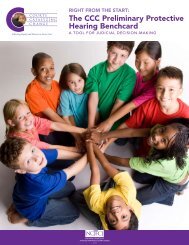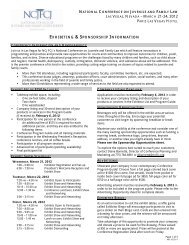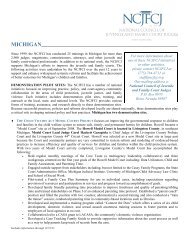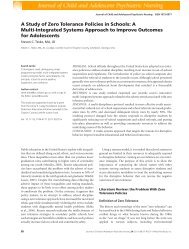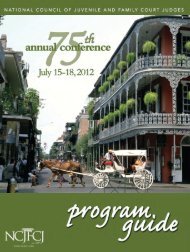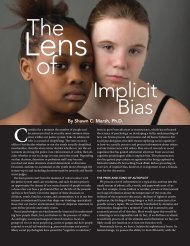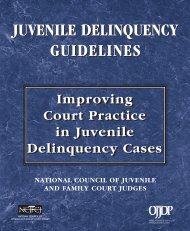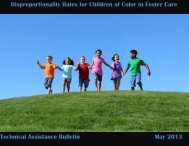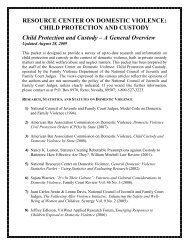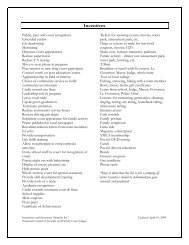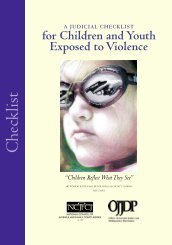20 JUSTICE POLICY INSTITUTEbrutality, including students being hit withbatons, thrown into lockers, stomped on, andhandcuffed and placed in a room, alone forhours. 69 Of 131 students surveyed in one schoolin Palm Beach County, 35 percent said they feltprotected, while 65 percent said that they felt“something other than protected, includingintimidated and harassed.” 70The ACLU of Michigan also found numerousexamples of students feeling intimidated bySROs because they tend to arrest first and askquestions later and, in some cases, they haveused force under concerning circumstances. Asone example, a student became agitated becausehe was going to be suspended and removedfrom the school premises; after threatening tofight with the officer, the officer tasered thestudent. 71 These incidents of violence are notonly disruptive in school, but students also learnto distrust police in their communities.An increased presence of police in schools alsoremoves the opportunity school officials oncehad to teach students proper behavior andconduct that can be applied after school, in thecommunity, and at a job. 72 For example, fightingstudents could be taught how to diffuse aconflict, rather than be arrested and adjudicateddelinquent. In fact, peer mediation, student-ledconflict resolution, and restorative justice have allbeen shown to reduce incidents of harm atschools, be a good educational experience, andcreate a sense of satisfaction for studentsinvolved, including the student that experiencedharm. 73SOME CHILDREN INTENTIONALLY LEFT BEHIND?High stakes tests, especially associated with No Child Left Behind, were widely adopted in the early2000s. Although a purpose of the tests may have been to identify students needing additionalassistance, they became an instrument that school districts, states and the federal government use todetermine if the school is performing and meeting “annual yearly progress.” Schools thatunderperform are subject to a number of consequences, not the least of which is being labeled a“failing school” from which students can transfer.As a result, schools are under immense pressure to ensure that their students meet annual yearlyprogress, particularly schools that serve students that face challenges related to educationalattainment. An achievement gap between white students and black students, English languagelearners, and students with special needs all pose challenges to school performance.At the same time that No Child Left Behind has become part of school systems, zero tolerancepolicies and the use of SROs have only grown in popularity. A coalition of organizations called Dignityin Schools has gathered extensive evidence indicating that these tests are not only used as ameasure of school performance but a means by which schools determine which students might betargeted for suspension, expulsion or arrest. In other words, by removing underperforming students,schools would perform better. Increases in referrals to the juvenile justice system from schools notedin Texas, Philadelphia, Chicago, Florida, Denver, and Louisiana may be indicators that “test, punish,and push out” may be a growing practice.Source: Advancement Project, Test, Punish, and Push Out: How Zero Tolerance and High Stakes Testing FunnelYouth Into the School to Prison Pipeline, (Washington, DC: Advancement Project, 2010).www.advancementproject.org/sites/default/files/publications/rev_fin.pdf
<strong>EDUCATION</strong> <strong>UNDER</strong> <strong>ARREST</strong> 21PART VISOME STUDENTS AREAFFECTED BY SROS MORETHAN OTHERSStudents of color and students with disabilities are the most likely to be affectedby harsh disciplinary policies and the school resource officers that go with them.The concentrated impact of punitive policies on these groups of youth alsocontributes to the numbers of youth of color and youth with special needs in thejuvenile justice system.Youth of colorNo data exists showing that SROs arrest youth ofcolor more often than white students, but otherdata shows that youth of color aredisproportionately arrested compared to whiteyouth. 74 In school, youth of color are far morelikely to be subjected to harsh punishments inschool than whites. A study from the AppliedResearch Center shows that African Americanstudents are disciplined more often and moreharshly than white students. 75 Related tosuspensions, a 1998 study from the Departmentof Education Office for Civil Rights shows thatAfrican American and Hispanic students aresuspended from schools at disproportionaterates compared to white students. 76In addition to these national statistics related todisproportionate punishment generally, schooldistrict-level analyses by the AdvancementProject show overwhelming disproportionalitiesrelated to arrests: 77• In 2001, the Pinellas County (Florida)School District Police made 146 arrests, ofwhich 54 percent were of black students.Comparatively, 19 percent of the District’senrollment is black.• In South Carolina, black students aremore likely to be referred to lawenforcement than their white peers. Blackstudents make up 42 percent of studentenrollment, but 75 percent of disorderlyconduct charges, of which 90 percent arereferred to law enforcement.• In the 2001 – 2002 school year, Latinostudents were 22 percent of studentenrollment, but 34 percent of referrals tolaw enforcement agencies in Colorado.• A study by the ACLU of Connecticutfound that in East Hartford in the 2006-07school year, African American andHispanic students together accounted for69 percent of the student population, but85 percent of school-based arrests. In WestHartford, African American and Hispanicstudents were 24 percent of the studentpopulation, but 63 percent of arrests. 78



